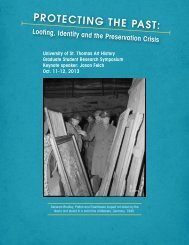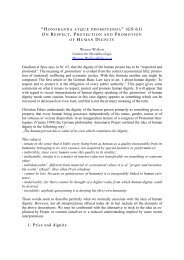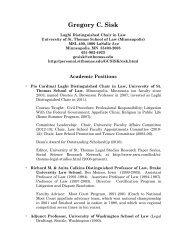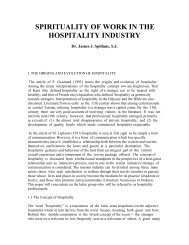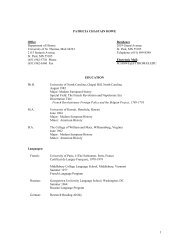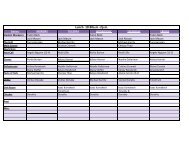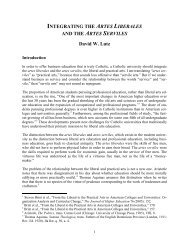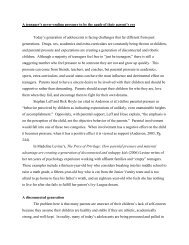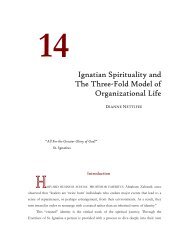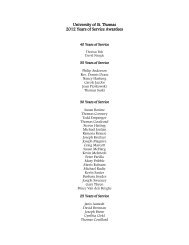dr. ronald e. mcnair acknowledgements - University of St. Thomas
dr. ronald e. mcnair acknowledgements - University of St. Thomas
dr. ronald e. mcnair acknowledgements - University of St. Thomas
Create successful ePaper yourself
Turn your PDF publications into a flip-book with our unique Google optimized e-Paper software.
72<br />
A QUALITATIVE<br />
ANALYSIS OF<br />
TEACHERS’<br />
PERCEPTION<br />
TOWARDS HMONG<br />
AMERICAN<br />
STUDENTS’<br />
ACADEMIC<br />
ACHIEVEMENT IN<br />
MINNESOTA<br />
Mai-Eng Lee ’12<br />
<strong>University</strong> <strong>of</strong> <strong>St</strong>. <strong>Thomas</strong><br />
Mentor<br />
Ken<strong>dr</strong>a Garrett, Ph.D.<br />
Pr<strong>of</strong>essor <strong>of</strong> Social Work<br />
<strong>University</strong> <strong>of</strong> <strong>St</strong>. <strong>Thomas</strong><br />
ABSTRACT<br />
Minnesota has a growing population <strong>of</strong> Hmong American students who are <strong>dr</strong>opping<br />
out <strong>of</strong> public high schools and graduating at lower rates than their counterparts at<br />
significantly higher rates, especially in the Twin Cities area. Through qualitative<br />
research, this study explores the perceptions <strong>of</strong> six teachers who have taught Hmong<br />
students throughout their teaching career in regards to the necessary parental and<br />
academic support that will empower Hmong students to excel in their academic success.<br />
The results show Hmong students have literacy challenges with reading, writing, and<br />
verbal communication in English. It is also evident from the current study Hmong<br />
students are in need <strong>of</strong> a culturally sensitive school environment to help them identify<br />
and learn about their own culture and language. In addition, Hmong students need a<br />
supportive home environment that provides a quiet study space and some hands-on<br />
learning activities to actively engage them in their learning. Moreover, regardless <strong>of</strong> the<br />
lack <strong>of</strong> Hmong parents’ academic involvement within and intimidation by their<br />
chil<strong>dr</strong>en’s school, they value education and want to understand the Western education<br />
system to better provide a supportive home environment for their chil<strong>dr</strong>en. Therefore, it<br />
is essential for teachers and other school pr<strong>of</strong>essionals to collaborate and communicate<br />
with Hmong parents in assisting Hmong students with the academic learning activities<br />
to help them succeed in school. Further research is needed with Hmong parents and<br />
students in order to understand how they perceive the Western education system.<br />
The Hmong are an ethnic minority group <strong>of</strong> people. Though there are no<br />
accurate records or evidence to prove where Hmong originated, scholars<br />
suggested Hmong people came from the mountains <strong>of</strong> Southern China and<br />
migrated over centuries to Vietnam, Thailand, Laos, and Burma. After the<br />
Secret War <strong>of</strong> Laos in 1975, some <strong>of</strong> the Hmong people immigrated to the<br />
United <strong>St</strong>ates. According to the U.S. Census 2000, Minneapolis and Saint Paul<br />
are home to 97.3 percent <strong>of</strong> the Minnesota Hmong population at 44,205.<br />
However, the American Community Survey (2007) estimated that the Hmong<br />
American population in Minnesota is probably between 60,000 and 70,000<br />
because Hmong have a young population and it is a fast growing community<br />
(Lee & Pfeiffer, 2010).<br />
Thirty-six years after Hmong arrived in the United <strong>St</strong>ates, education has<br />
continuously been one <strong>of</strong> the most challenging issues facing Hmong American<br />
chil<strong>dr</strong>en. Problems such as low educational attainment, high <strong>dr</strong>op-out rates,<br />
low test scores, and other education-related issues have preoccupied the Hmong<br />
American community (Yang, 2003). According to Yang and Pfeiffer (2003),<br />
Hmong refugees were pre-literate before they entered the United <strong>St</strong>ates in<br />
1975. This was not unexpected because most <strong>of</strong> the Hmong <strong>of</strong> Laos did not<br />
have their first village school until circa 1939, and only a few Hmong families<br />
could afford to send their sons to school at that time (Yang & Pfeiffer, 2003).<br />
This historical background and the cultural assimilation in America meant<br />
Hmong had to start their educational development and new way <strong>of</strong> life at the<br />
very base <strong>of</strong> society. After over thirty years in the United <strong>St</strong>ates, Hmong<br />
Americans have observed successes, though they continue to face challenges<br />
in academic achievement (Yang & Pfeiffer, 2003).



